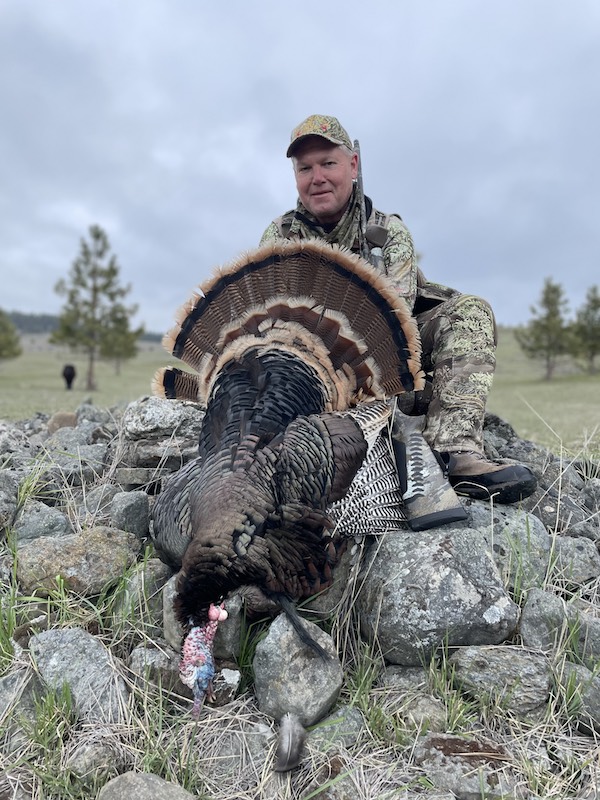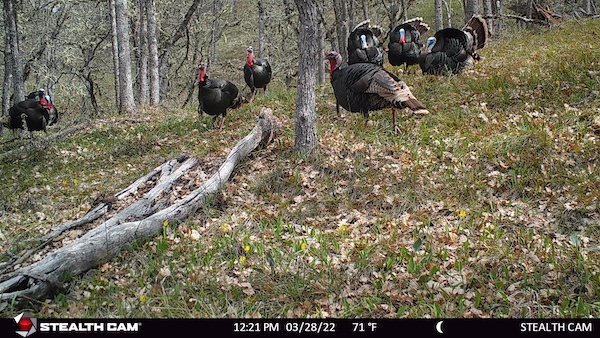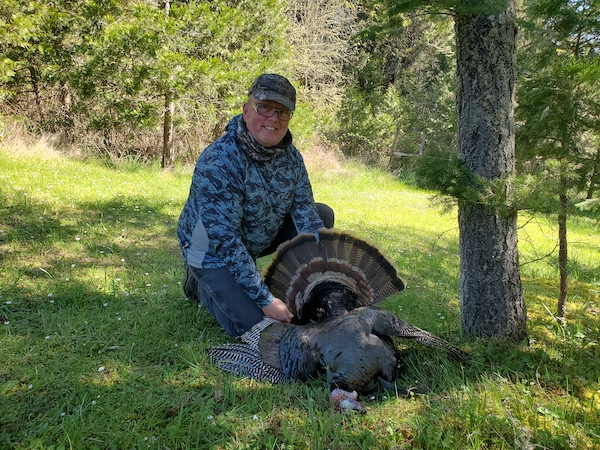
2023 Oregon, Washington Spring Turkey Preview
By M.D. Johnson
I was fortunate enough to catch up with Sarah Garrison, small game/upland bird/furbearer specialist for the Washington Department of Fish and Wildlife, along with Mikal Cline, upland game bird coordinator with the Oregon Department of Fish and Wildlife, to get their take on what turkey hunters can expect once season rolls around come mid-April.
Encouraging news, it is, whether you’re planning to spend your mornings in the Evergreen State or across the river in the Beaver State, or both.

WASHINGTON
As she did last year, Garrison came out of the blocks with good news for Evergreen State turkey hunters.
“Washington’s turkey population,” she says, “continues to do very well. Harvest increased 57 percent in the 2021 spring season from the previous year. Hunter success dropped slightly to 48 percent, but remains above the average from the last 10 years.”
As for a subspecies by subspecies breakdown on how each is faring – Washington is currently home to three of the country’s four varieties of Meleagris gallopavo: easterns, Merriam’s and Rio Grandes – Garrison states that Eastside birds “are doing very well, with both populations being self-sustaining.” Meanwhile, the eastern subspecies, found in small pockets west of the Cascades “where suitable habitat is limited, continues to sustain in low numbers.” The biologist adds that Rio Grandes in Southeast Washington “likely stabilized (numerically) about five years ago, while the Merriam’s are stable and continuing to increase in some areas.”

In years past, the populations of both Merriam’s and Rio Grandes increased in some locales to the point of being problematic; that is, well, too much of a good thing for some agriculturalists, farmers and vineyard owners. Twenty turkeys is one thing; 520 birds milling about one’s barnyard before roosting in one’s hayloft is another. Five hundred turkeys produce a lot of, er, organic waste material, which, unfortunately, doesn’t do the hay or the $300,000 John Deere combine underneath them much good.
“The WDFW,” says Garrison, “still receives complaints from developed areas across Central and Eastern Washington, especially in the winter when snow makes access to natural food sources more difficult.”
(Turkey populations on some islands in the San Juans, including Orcas, can also cause issues, though public hunting access is very limited.)
It’s no secret now that since 2020, otherwise known as The Year of Covid, there’s been an uptick – often a huge uptick – in the number of folks getting outside and enjoying what Mother Nature has to offer. Angling. Waterfowl hunting. Camping. Recreational vehicle use. Hell, bird watching and day hiking all have grown in popularity, thanks to that little global bug and the human desire to get outside and do, well, something. Turkey hunting? Not immune.
“From 2012 through 2019,” says Garrison, “the number of spring turkey remained relatively stable, with a slight (6 percent) increase in participation during the 2019 season.”
Garrison says that while participation dropped some 16 percent during Washington’s Covid-shortened 2020 spring season, hunter numbers rose an incredible 63 percent during 2021.
“Harvest,” she continues, “has followed a similar, though muted, trajectory as expected, with that overall increasing trend from 2012 through 2021.”
Washington state turkey hunters can expect no regulatory changes for the 2023 spring season, a nice change considering the hunting/fishing pamphlets seem to get bigger and bigger each year. What hunters can expect, says Garrison, is that perennial “best bets” will continue to shine. This includes the northeastern part of Washington, with a spotlight on Pend Oreille, Stevens and Spokane Counties for Merriams, along with the southeast corner and Asotin, Columbia, Garfield, Whitman and Walla Walla Counties for Rio Grandes.

“We’ll leave the easterns alone,” Garrison says, and I couldn’t agree more. Easterns here are a small, secretive, stable-but-not-expanding-much-at-all population, essentially limited to pockets scattered from around Olympia – being vague – south to portions of Cowlitz County and – again, being vague – points in between. Traditional eastern haunts have been well-documented in print and online over the past 20 years, and those haven’t changed much, if at all. Want an eastern here? Be willing to devote your time, boot leather and your season to finding one; then, it’s just a matter of convincing him you’re a good-looking Mama Turkey. Do so, though, and you’re well on your way to the Washington Turkey Slam – harvesting all three subspecies in a single season.
OREGON
Across the Big River, Garrison’s Beaver State counterpart is Mikal Cline, ODFW’s upland game bird coordinator.
“The hatch going into spring 2022 was of concern,” Cline begins somewhat ominously. “If you’ll remember, we had a switch in the weather in late April. We’d had a dry winter up till that point, and then the weather switched and it started getting wet and snowy and rainy, and the temperatures dropped right in the middle of incubation and (the) hatch. So, we had some concerns about upland bird recruitment in general. Turkeys tend to nest in higher elevations, where the snow was accumulating. I’m not sure (the concerns) were justified.”

To be fair, and at the time I spoke with Cline, she and assistant Kelly Walton were waiting for and eagerly anticipating the 2022 harvest data; however, that information wasn’t as yet in hand. Cline was happy to speak of the ’22 spring turkey season success anecdotally.
“I never heard that people were having a hard time finding birds,” Cline says. “We did hear, specific to the fall season, there were some pretty young poults, which meant that our hens were successful in renesting. That wasn’t range-wide, and it’s definitely good news. There are still plenty of birds out there on the landscape.”
As did Garrison, Cline spoke to the human variable in Oregon’s turkey hunting equation. Numbers up since the pandemic? Down? “Turkey hunting has been increasing in popularity in Oregon,” she says. “We had a large bump in both hunter numbers and hunter effort in 2020, and it does seem like we’ve been able to maintain that increase (since then). Two big reasons why people choose to go hunting or not choose to go hunting, and that’s time and access. We’ve been working hard on the access side, especially closer to our urban areas. That’s been contributing a bit. People had time in 2020 to figure things out, whether they were new hunters, continuing hunters, or reactivated (hunters). And we have plenty of turkeys here in Oregon to sustain this increase.”
Again similar to Washington, Cline says that although it being a “little too early to comment,” the agency isn’t proposing any regulatory changes for the 2023 spring season. However, the fall hunt might prove a different scenario.
“We’re looking at some type of pilot season – some pilot project – to address crop depredation in the John Day Valley,” she says. “Something to get the (turkey population) to tolerable levels in the wintertime. We’re looking at different ideas; we just have to be certain we (ODFW) have the authority to do them.”
Where Cline is especially optimistic is in the realm of opportunity – public access throughout Oregon to hunting ground that harbors good to even excellent populations of wild turkeys.
“Oregon has a lot of great options,” she states. “Unfortunately, the Willamette Valley is primarily private land, and there are some big flocks there, but finding access can be tricky.”
As a possible alternative, Cline suggests hunters research the agency’s Hunt By Reservation System (myodfw.com/HBR).
“It’s a lottery-style program,” she says, “and it’s been (to date) successful. People can put their name in the hat and hopefully draw a spot on some pretty nice properties that have a lot of turkeys.”
In terms of public access, the coordinator speaks highly of the southwest corner of the state, “where we really do have strong turkey populations, especially in the Rogue District, with good Forest Service and Bureau of Land Management access adjacent to private lands.”

In the eastern half of the Beaver State, where Cline defines opportunity as being a “ton of public access,” the Blue Mountains continue to be a traditional producer of good hunts, many coming courtesy of ground owned and managed by USFS. Some of the more popular “jumping-off points,” she suggests, include John Day “in any direction,” La Grande and Prineville.
The White River area on the east side of Mt. Hood can be productive; however, “we don’t always recommend that,” Cline admits, “as it does get hunted pretty hard, and those birds didn’t have great production (in 2022). There’s a lot of hunter use out there. But if folks are willing to travel a little further east, they’ll have a better experience.”
Editor’s note: This article appeared in the March 2023 issue of Northwest Sportsman. For even more spring turkey hunting coverage, keep an eye out for the April 2023 issue, featuring even more Oregon and Washington intel, an expert’s top 10 tips for tricking toms, best shotgun loads and Chef Randy’s turkey empanadas recipe!
